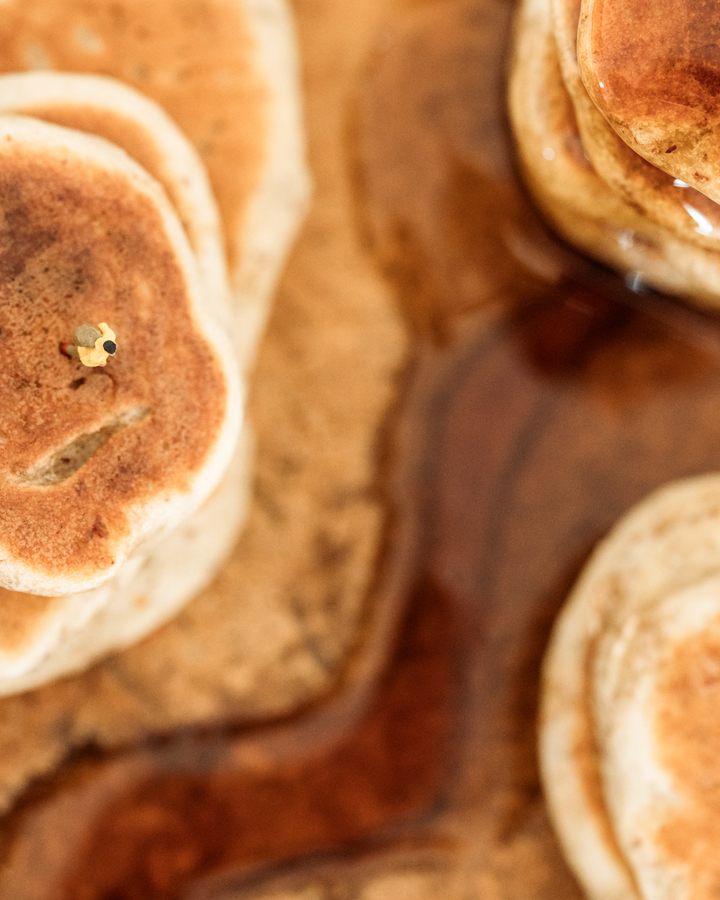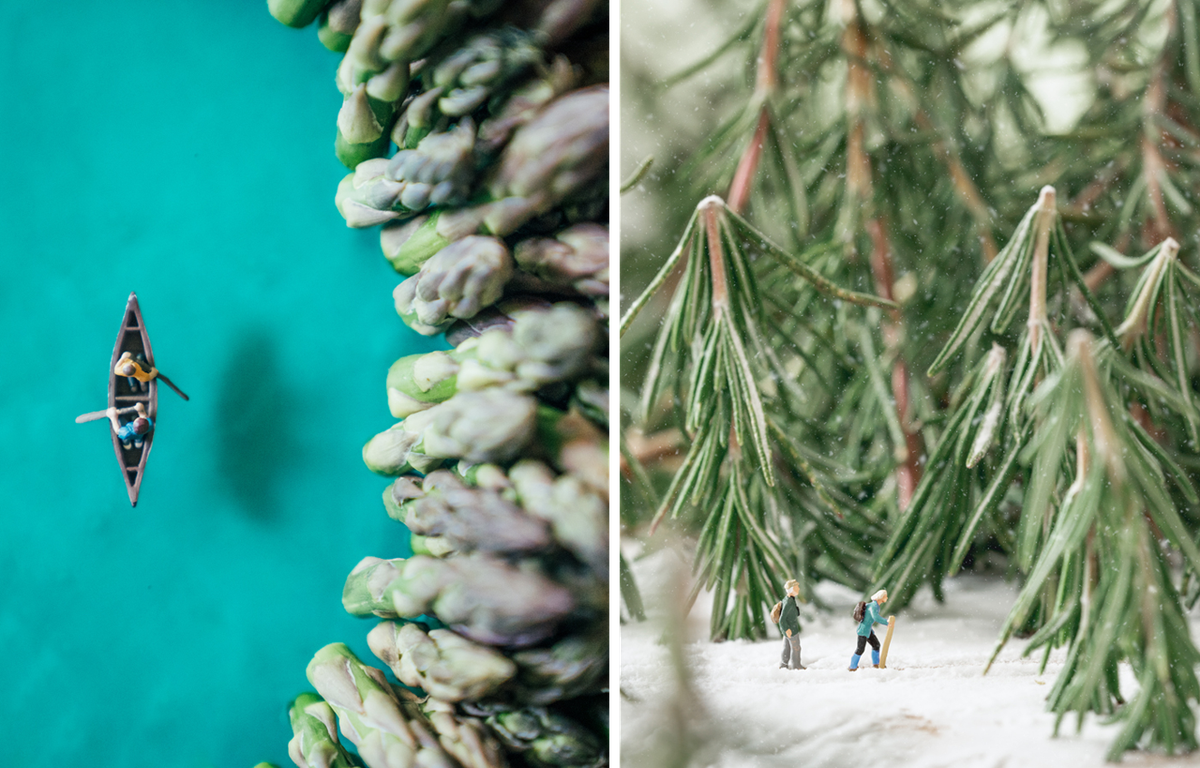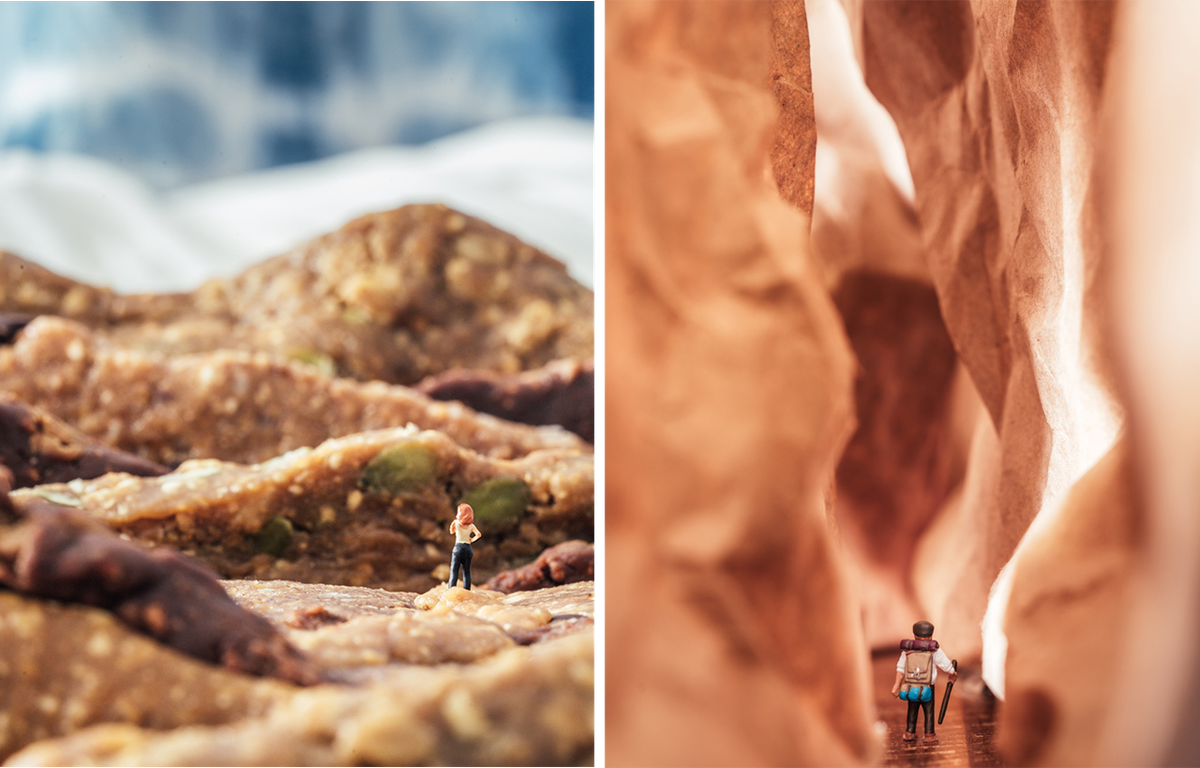
How a Photographer Recreated Outdoor Adventures With Household Stuff
Think of it as the Great Indoors.
From above, a lone figure with a backpack can be seen peering down at a brown river that flows at the bottom of what appears to be a deep desert canyon. Los Angeles–based travel photographer Erin Sullivan did not not ride a helicopter or use a drone to get this remarkable aerial view. She used stacks of pancakes.
When Sullivan’s travel plans were canceled, as nearly 40 million Californians were ordered to stay at home in mid-March for the COVID-19 pandemic, she channeled her curiosity for nature into creativity—using her pantry, laundry, and other household items. Pancakes, onions, gelatin, and other edibles helped her recreate the wonder of outdoor adventures, and she also used aluminum foil to make a shimmering lake and tie-dye sheets to evoke an ice cave. She then photographed her scenes to make it look like they were actually captured out in the wild.
“This has definitely been an opportunity to learn, and has taught me a few things,” Sullivan wrote in an email. “Because I’m making these tiny scenes and trying to make them seem grand and real, I have to pay attention to the details in each item—the light, the texture, the color.” She has inspired others with her Instagram by sharing the challenge to create their own miniature indoor adventures. Sullivan posted, “Staying home is literally a life saver right now, and your inner artist can thrive given any restriction.”

Atlas Obscura talked to Sullivan about missed trips, glowing caves in New Zealand, and her inspiration in challenging times.
What travel were you planning when shelter-at-home started in Los Angeles?
Normally I spend about a third of my time on the road, shooting and filming for tourism boards, brands, and other projects. Before things got serious in L.A., I was home preparing for upcoming trips. I had several shoots planned, to film episodes of the miniseries I host for REI called In Our Nature, about the future of the outdoors. Since we can’t shoot those episodes right now, we’ve been creating a few mini-episodes about how the pandemic is affecting our connection to nature, among other topics. For international travel, I had been planning a hiking trip to the Dolomites in Italy for a group I had previously led on a Greece adventure, and I was in the midst of planning a couple of personal trips and hadn’t landed on a location yet. Guatemala and Mexico were options I was looking at for the spring.
I was keeping an eye on how things were going in Italy and assumed it could go that way for us here in the States. So while hiking was still allowed, I was going on solo hikes and enjoying peaceful time in nature. I started to think about how I could pivot my business if all of my trips were canceled. A few weeks later, they were.
What inspired you to start recreating outdoor scenes?
I pursued a career in travel and outdoor photography because I love it. I cherish the time I spend outdoors and around the world, and I miss it dearly. But I also see this as an invitation to turn inward and push myself creatively. The idea to recreate outdoor scenes in my house came when I began asking myself how I’d stay creative and connected to the outdoors while following stay-at-home guidelines. When I was a kid I’d imagine little adventures happening in corners of my bedroom or in my blankets when I couldn’t fall asleep. That came to mind when I was brainstorming. I thought, “Hmm, maybe it would be fun to create a series of images of tiny adventures made of household objects.” I sketched out a handful of ideas and created them, and saw quickly that this could be a series that really works. I’ve never photographed miniatures before, so this is new for me!

How are you staying creative and motivated?
I have to release the expectation of it. I have to let it be fun. I’m definitely not motivated to create every single day—I think now is a time to be really gentle with ourselves. I have been trying to create three to four sets of images for this series every week. Journaling, going for walks around my neighborhood, prayer/meditation, listening to music, reading, and dancing like an idiot have all been immensely helpful. Over the years I have learned which of my practices help me to stay creative and keep things flowing. Journaling is probably the biggest. I don’t write anything groundbreaking, but it’s just to get the gunk out of my brain and keep things moving.
What’s your favorite shot from the series?
My favorite shots from this series are the ones that have the most sentimental value for me. At the top of the list is the “Glowing Cave” I made from rain jackets and tin foil. It took me about 20 minutes to set up, and I spent about an hour shooting the scene. I had a super-clear idea in my head all day of what I wanted to create, and which materials would help me to accomplish it. By the time I had a free moment, it was 10 p.m., but the idea was so clear that I didn’t want to wait until the next night. (This one had to be shot in darkness.) Once I had things set up, I played with the objects looking for different angles. I also experimented with putting a canoe in the “river” but ended up liking the people standing as a better way to communicate scale.
Ever since I first visited New Zealand in 2014, I have been completely fascinated by glow worms and the caves they live in. I wanted to create an image that represents how it feels to stand in one of those caves. There are certainly elements of fantasy in this set, and that’s purposeful. These images aren’t meant to be 100 percent literal, but to communicate the way the outdoors and travel make us feel when we are experiencing them.
This interview was edited for length and clarity.























Follow us on Twitter to get the latest on the world's hidden wonders.
Like us on Facebook to get the latest on the world's hidden wonders.
Follow us on Twitter Like us on Facebook